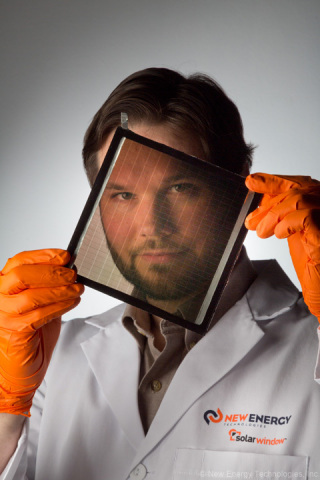An innovative developer of next generation alternative and renewable energy technologies hopes to soon be outfitting high-rise buildings with windows that generate electricity.
Maryland-based New Energy Technologies has already developed see-through coatings capable of generating electricity on glass and flexible plastics. Their newest window arrays, which they call SolarWindow, measure ablout 36 square-inches and have highly-uniform, colored tints that are preferred by commercial window manufacturers for installation on high-rises.

New Energy’s Principal Scientist, Dr. Scott Hammond, shows off the company’s electricity generating window.
“Accomplishing these goals allows us to now advance towards larger area, commercial scale windows while maintaining uniform, neutral colors and scalable power,” explained Mr. John A. Conklin, President and CE. “Among the most important criteria for developing SolarWindow applications for today’s skyscrapers is providing a set of neutral colors that remain see-through and are uniform in fabrication. Today, we’ve revealed a record-breaking, largest-area see-through, organic photovoltaic (OPV) SolarWindow array that addresses tall-tower and commercial building glass requirements, they also bear the promise of facile scale-up capabilities and unparalleled manufacturability,” Conklin added.
An organic solar cell consists of two semiconducting layers made of plastic polymers. When a photon is absorbed (light), it displaces an electron in a polymer atom, leaving behind an empty space (hole). The electron and the hole form an exciton. The exciton immediately splits, allowing the electron to move to another hole created by another incoming photon. This continuous movement of electrons produces the electric current.
The U.S. Department of Energy’s National Renewable Energy Laboratory (NREL) is among the world’s most respected and advanced solar-photovoltaic research institutions, and over its 37-year history has been credited for ground-floor support of many of the commercial technologies employed by today’s renewable energy industries. NREL and New Energy have been working through a Cooperative Research and Development Agreement to advance the company’s technology for generating electricity on glass windows.
“We continue to meet and exceed our device design, architecture, uniformity, color, and transparency development goals,” continued Conklin. “Accomplishing these goals allows us to now advance towards larger area, commercial scale windows while maintaining uniform, neutral colors and scalable power.”
The prospect of applying the windows to all four sides of a high-rise building provides a significant advantage over conventional photovoltaic solar-power systems. New Energy’s windows are capable of operating in both direct, diffuse, and shaded sunlight conditions; conventional systems suffer large efficiency losses, if able to work at all, under such conditions. The new glass also generates electricity from both natural and artificial light sources such as fluorescent, light emitting diodes (LED), and incandescent lights in offices; conventional systems become less efficient under these conditions, and again, may not work at all.
Unlike traditional building-applied photovoltaic (PV) systems, restricted to use in direct sunlight on very limited skyscraper rooftop space, the electricity generating windows are designed to operate in sunlight and shaded conditions on the many thousands of square feet of glass surfaces common to today’s high-rise towers – possibly a game-changing advantage.
In comparison to conventional crystalline and thin-film PV technologies, New Energy’s product does not require expensive high-temperature or high-vacuum production techniques inherent to conventional solar, and is constructed using organic materials (polymers), which can be dissolved into liquid form and applied to a variety of surfaces such as flexible plastics and glass.
Conklin hopes that his electricity-generating windows with neutral colors and scalable power will soon convince architects to specify his glass for skyscrapers. He envisions replacing today’s passive glass windows with his electricity-generating systems – such installations could contribute to the goal of self-powered skyscrapers.

